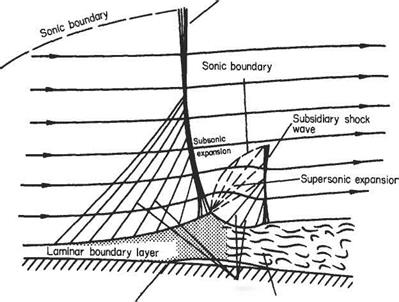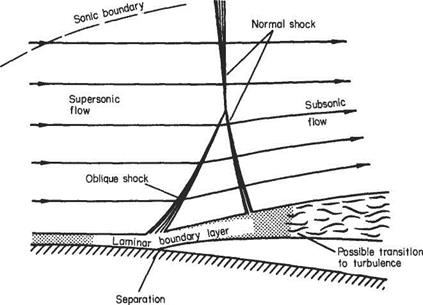Near-normal shock interaction with laminar boundary layer
There appear to be three general possibilities when a near-normal shock interacts with a laminar boundary layer. With a relatively weak shock, corresponding to an upstream Mach number just greater than unity, the diffused pressure rise may simply cause a gradual thickening of the boundary layer ahead of the shock with no transition and no separation. The gradual thickening causes a family of weak compression waves to develop ahead of the main shock (these are required to produce the supersonic mainstream curvature) and the latter sets itself up at an angle, between itself and the upstream surface, of rather less than 90° (see Fig. 7.49). The compression waves join the main shock at some small distance from the surface, giving a diffused base to the shock.
Immediately behind the shock, the boundary layer tends to thin out again and a local expansion takes place which brings a small region of the mainstream up to a slightly supersonic speed again and this is followed by another weak near-normal
|
|
shock which develops in the same way as the initial shock. This process may be repeated several times before the mainstream flow settles down to become entirely subsonic. Generally speaking this condition is not associated with boundary-layer separation, although there may possibly be a very limited region of separation near the base of the main shock wave.
As the mainstream speed increases so that the supersonic region is at a higher Mach number, the above pattern tends to change, the first shock becoming very much stronger than the subsequent ones and all but one of the latter may well not occur at all for local upstream Mach numbers much above 1.3. This is to be expected, because a strong first shock will produce a lower Mach number in the mainstream behind it. This means that there is less likelihood of the stream regaining supersonic speed. Concurrently with this pattern change, the rate of thickening of the boundary layer, upstream of the first and major shock, becomes greater and the boundary layer at the base of the normal part of the shock will generally separate locally before reattaching. There is a considerable possibility that transition to turbulence will occur behind the single subsidiary shock. This type of flow is indicated in Fig. 7.50.
With still greater local supersonic Mach numbers, the pressure rise at the shock may be sufficient to cause separation of the laminar boundary layer well ahead of the main shock position. This will result in a sharp change in direction of the mainstream flow just outside the boundary layer and this will be accompanied by a well-defined oblique shock which joins the main shock at some distance from the surface. This type of shock configuration is called a lambda-shock, for obvious reasons. It is unlikely that the boundary layer will reattach under these conditions, and the secondary shock, which normally appears as the result of reattachment or boundary – layer thinning, will not develop. This type of flow is indicated in Fig. 7.51. This sudden separation of the upper-surface boundary layer on an aerofoil, as Mach number increases, is usually associated with a sudden decrease in lift coefficient and the phenomenon is known as a shock stall.
Compression
![]()
 ,___ . .. waves Transition to
,___ . .. waves Transition to
Laminar separat. on turbulence and
reattachment
|
|
|













